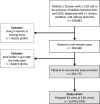Profiles of frequent emergency department users with chronic conditions: a latent class analysis
- PMID: 36175089
- PMCID: PMC9528600
- DOI: 10.1136/bmjopen-2021-055297
Profiles of frequent emergency department users with chronic conditions: a latent class analysis
Abstract
Objectives: Frequent emergency department users represent a small proportion of users while cumulating many visits. Previously identified factors of frequent use include high physical comorbidity, mental health disorders, poor socioeconomic status and substance abuse. However, frequent users do not necessarily exhibit all these characteristics and they constitute a heterogeneous population. This study aims to establish profiles of frequent emergency department users in an adult population with chronic conditions.
Design: This is a retrospective cohort study using administrative databases.
Setting: All adults who visited the emergency department between 2012 and 2013 (index date) in the province of Quebec (Canada), diagnosed with at least one chronic condition, and without dementia were included. Patients living in remote areas and who died in the year following their index date were excluded. We used latent class analysis, a probability-based model to establish profiles of frequent emergency department users. Frequent use was defined as having five visits or more during 1 year. Patient characteristics included sociodemographic characteristics, physical and mental comorbidities and prior healthcare utilisation.
Results: Out of 4 51 775 patients who visited emergency departments at least once in 2012-2013, 13 676 (3.03%) were frequent users. Four groups were identified: (1) 'low morbidity' (n=5501, 40.2%), (2) 'high physical comorbidity' (n=3202, 23.4%), (3) 'injury or chronic non-cancer pain' (n=2313, 19.5%) and (4) 'mental health or alcohol/substance abuse' (n=2660, 16.9%).
Conclusions: The four profiles have distinct medical and socioeconomic characteristics. These profiles provide useful information for developing tailored interventions that would address the specific needs of each type of frequent emergency department users.
Keywords: ACCIDENT & EMERGENCY MEDICINE; HEALTH SERVICES ADMINISTRATION & MANAGEMENT; PUBLIC HEALTH; STATISTICS & RESEARCH METHODS.
© Author(s) (or their employer(s)) 2022. Re-use permitted under CC BY-NC. No commercial re-use. See rights and permissions. Published by BMJ.
Conflict of interest statement
Competing interests: None declared.
Figures



Similar articles
-
Persistent frequent emergency department users with chronic conditions: A population-based cohort study.PLoS One. 2020 Feb 12;15(2):e0229022. doi: 10.1371/journal.pone.0229022. eCollection 2020. PLoS One. 2020. PMID: 32050010 Free PMC article.
-
Profiles of Frequent Geriatric Users of Emergency Departments: A Latent Class Analysis.J Am Geriatr Soc. 2021 Mar;69(3):753-761. doi: 10.1111/jgs.16921. Epub 2020 Nov 6. J Am Geriatr Soc. 2021. PMID: 33156527
-
Factors associated with chronic frequent emergency department utilization in a population with diabetes living in metropolitan areas: a population-based retrospective cohort study.BMC Health Serv Res. 2017 Aug 4;17(1):525. doi: 10.1186/s12913-017-2453-3. BMC Health Serv Res. 2017. PMID: 28778161 Free PMC article.
-
Characteristics and predictors of adult frequent emergency department users in the United States: A systematic literature review.J Eval Clin Pract. 2019 Jun;25(3):420-433. doi: 10.1111/jep.13137. Epub 2019 May 2. J Eval Clin Pract. 2019. PMID: 31044484
-
Experience of being a frequent user of primary care and emergency department services: a qualitative systematic review and thematic synthesis.BMJ Open. 2020 Sep 9;10(9):e033351. doi: 10.1136/bmjopen-2019-033351. BMJ Open. 2020. PMID: 32912938 Free PMC article.
Cited by
-
Emergency Department Use among Patients with Mental Health Problems: Profiles, Correlates, and Outcomes.Int J Environ Res Public Health. 2024 Jun 30;21(7):864. doi: 10.3390/ijerph21070864. Int J Environ Res Public Health. 2024. PMID: 39063441 Free PMC article.
-
Profiles of Emergency Department Users with Psychiatric Disorders Related to Barriers to Outpatient Care.Int J Environ Res Public Health. 2024 Feb 16;21(2):234. doi: 10.3390/ijerph21020234. Int J Environ Res Public Health. 2024. PMID: 38397723 Free PMC article.
-
Referral pathways for chronic pain patients from Canadian emergency departments: emergency physicians' practices, perspectives, and recommendations.CJEM. 2023 Sep;25(9):761-767. doi: 10.1007/s43678-023-00566-3. Epub 2023 Aug 26. CJEM. 2023. PMID: 37633868
-
Characteristics of High-Resource Health System Users in Rural and Remote Regions: A Scoping Review.Int J Environ Res Public Health. 2023 Apr 4;20(7):5385. doi: 10.3390/ijerph20075385. Int J Environ Res Public Health. 2023. PMID: 37047999 Free PMC article.
-
Frequent Users in Psychiatric Consultations: A 6-Year Retrospective Study in the Emergency Department.Int J Environ Res Public Health. 2025 May 23;22(6):828. doi: 10.3390/ijerph22060828. Int J Environ Res Public Health. 2025. PMID: 40566256 Free PMC article.
References
Publication types
MeSH terms
Substances
LinkOut - more resources
Full Text Sources
Medical
